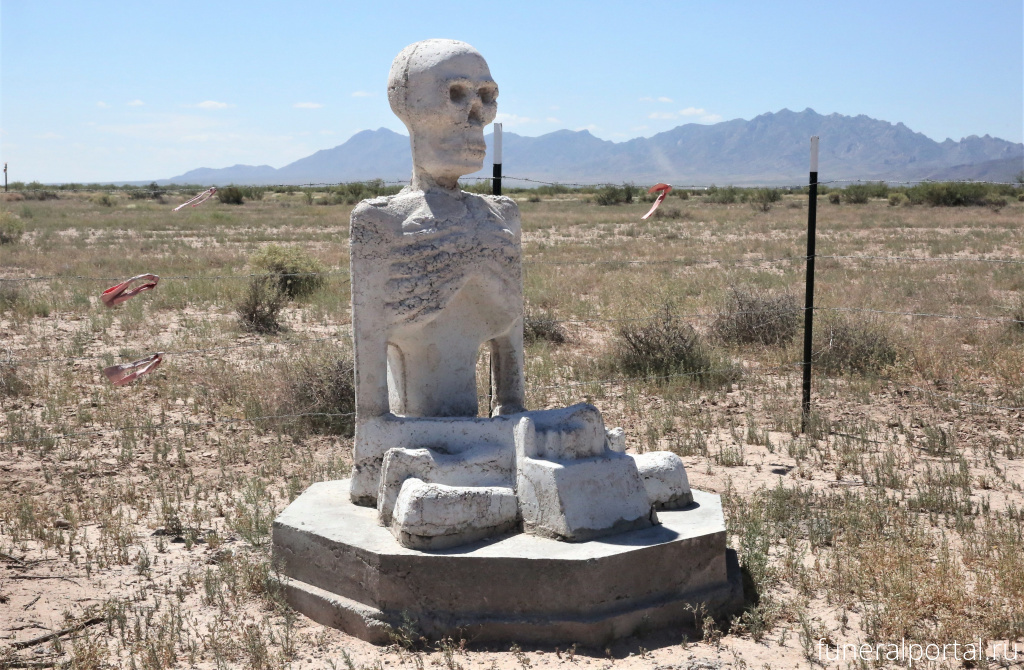Algernon D'Ammassa Las Cruces Sun-News
DEMING - Driving along the two-lane state highway 549 near Akela Flats east of Deming, glancing toward the Florida Mountains, one might spot an unusual figure gazing back at them.
The concrete statue depicts a skeleton — seated cross-legged on a platform in a seated pose reminiscent of traditional Buddhist art — yet also resembling calacas, the playful skeleton figures associated with the Mexican holiday Día de los Muertos.
Two identical statues, standing about five feet in height and weighing as much as 1,000 pounds apiece, quietly sit on private land in this expanse of open range in Luna County.
Their sculptor, Sean Blaine, has plans to erect more of them — as many as 20 — for an installation titled "Siddhartha is Dead." The name refers to Siddhartha Gautama, the figure from ancient India known as the Buddha and for whom the Buddhist religious tradition is named.
"It's a reminder that we all die," said Blaine, a Deming real estate agent and broker, in an interview, linking his work to the tradition of the memento mori — a Latin phrase meaning "Remember that you must die," in art.
The first two statues sit on land that Blaine owns, but he said he has also proposed sites to other property owners in the county, and has considered larger versions, as well.
"I see it as a point of curiosity. Like, 'Hey, what's that thing doing there out in the middle of nowhere?'" he said, over a soft drink at the nearby Adobe Deli restaurant.
The statues are constructed using five separate molds, the pieces cast in custom-mixed concrete with rebar holding the sections together. In all, completing one of the statues requires about 24 hours.
Blaine has been a local resident for 18 years and holds a degree in 3D sculpture design from the University of Minnesota. He even wears his own work: Two partial prosthetic fingers, printed in nylon, using a complex, flexible design of his own that he made available for free online. His partial loss of a thumb and a finger, he said, followed an accident with a table saw long ago.
While he has long been interested in Buddhism, Blaine spoke of any religious or spiritual significance of his art with tongue in cheek.
After suggesting the statues together constitute a "temple of peace," he added, "It's not necessarily a Buddhist temple. Because, in my mind, 'Buddhist temple' is an oxymoron. ... It's a sculpture. It's no more sacred than the dirt it's sitting on — and no less sacred than the dirt it's sitting on."
While the statues are accessible to the public, an up-close visit requires pulling off the road and onto a dirt path. The more visible of the two is beautifully flanked by the mountains, yet is also encircled in barbed wire fencing to protect it from cattle.
'Like a fun secret I found in the desert'
Blaine cited the "Mano de Desierto," a concrete and iron monument by sculptor Mario Irarrázabal portraying a gigantic hand reaching through the floor of the Atacama Desert in Chile, as an example of the power of art in remote locations.
Michelle LaFlamme-Childs, executive director of the state art agency New Mexico Arts, located the statues in a "long tradition" of gripping art installed in rural landscapes, such as works by Nancy Holt and Robert Smithson.
"I love those statues," said Pamm Reynolds, who lives in Luna County near Spring Canyon, told the Las Cruces Sun-News, describing them as "like a fun secret I found in the desert.
"I call them the 'Bony Buddha,'" she continued. "I love how the artists in and around the Deming area put their own unique touch to our world."
Not all neighbors are enamored with them, however.
Tawny O'Hara, who lives about three miles away from the statues, said, "I am not a fan, but to many it's art. I understand the culture of celebrating death more than life, but that is not my culture. So, to me, skeletons are not relative to life."
Yet Blaine said his point is not to dwell on death, but to turn the viewer's attention to life.
"If you don't know what's going to happen when you die, you should make good use of the time you've got now," he said.
Beyond that, he said he was happy to allow viewers to construct their own meaning and interact with the work on their terms.
"Public art is more than just pretty things," LaFlamme-Childs said. "It can be just something lovely to look at, but art does so much for us that we sometimes don't even realize. It can generate conversation around topics that might be difficult for people to think about. ... It can be hugely important in recognizing and pointing to history or culture that's deeply rooted in a community and making people who are part of that community and culture feel seen."
New Mexico Arts, a division of the state Department of Cultural Affairs, administers New Mexico's Art in Public Places Act, which sets aside 1 percent of capital outlay for new construction or major renovations for artwork at that location.
While that ensures state-supported public art is distributed throughout the state, including rural communities, those works tend to be connected with public buildings.
"Public art shouldn't be just for those in urban settings," LaFlamme-Childs said. "When you walk into a museum or even into a courthouse, you might already be kind of expecting to see art ... but driving down the road and coming upon something like that, it's such a discovery for people and evokes such joy."
"In general, the concept of art is that it's a mark of civilization," Blaine said. "If you can have people who can create beauty in the world, why not do that?"
Algernon D'Ammassa can be reached at 575-541-5451, adammassa@lcsun-news.com or @AlgernonWrites on Twitter.









